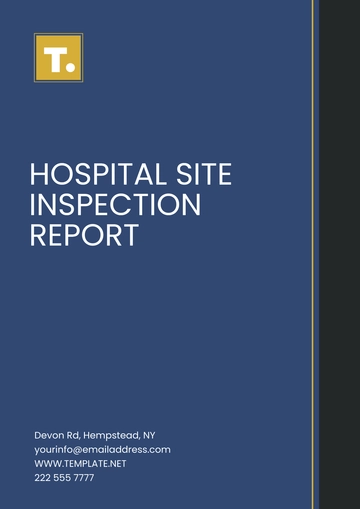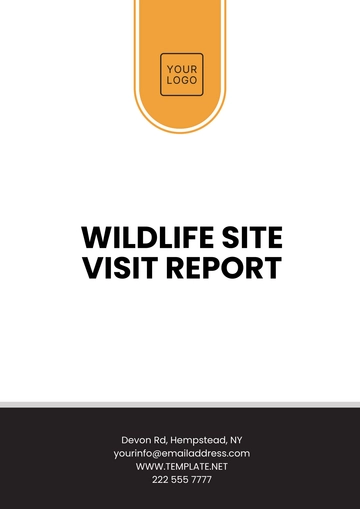Free Wildlife Site Visit Report

Date of Visit: December 15, 2054
Location: Pembroke Pines, FL 33028
Prepared By: [Your Name], Conservation Biologist
I. Introduction
The visit to Pembroke Pines, FL 33028 aimed to evaluate the sanctuary's current biodiversity, assess habitat conditions, and observe ongoing conservation efforts. The report summarizes key findings, identifies threats to the ecosystem, and proposes actionable recommendations.
II. Objectives
Assess the health of wildlife populations within the sanctuary.
Identify any ecological disturbances affecting flora and fauna.
Evaluate the impact of conservation programs implemented by the sanctuary.
Suggest strategies for improving habitat quality and species protection.
III. Methodology
Observation: Conducted systematic surveys along trails and wetland areas.
Interviews: Engaged with sanctuary staff and local guides for insights.
Documentation: Photographed species and habitat features.
Sampling: Used quadrat sampling to record plant diversity and camera traps for nocturnal animals.
IV. Key Findings
A. Wildlife Observations
Mammals:
Spotted three Philippine deer (Rusa marianna) in the forested areas.
Recorded a troop of 12 long-tailed macaques (Macaca fascicularis).
Birds:
Observed rare sightings of the Philippine eagle (Pithecophaga jefferyi).
Notable migratory birds included the black-winged stilt (Himantopus himantopus).
Reptiles and Amphibians:
Documented three species of freshwater turtles, including the endangered Philippine forest turtle (Siebenrockiella leytensis).
Insects:
High diversity of pollinators, including native butterfly species such as Troides magellanus.
B. Habitat Conditions
Forest cover is dense in the central zones but fragmented near the sanctuary borders.
Water quality in wetlands showed moderate pollution due to nearby agricultural runoff.
Vegetation included both native species like narra (Pterocarpus indicus) and invasive species such as Lantana camara.
C. Environmental Threats
Evidence of illegal logging observed near the northwestern boundary.
Instances of trash accumulation near visitor trails.
Increased human-wildlife conflict reported in surrounding villages.
D. Conservation Efforts
Active breeding programs for the Philippine deer and Philippine eagle.
Community-driven initiatives like guided eco-tours and conservation workshops.
Patrol teams monitor poaching and logging activities effectively in core zones.
V. Conclusions
The Pembroke Pines, FL 33028 serves as a vital refuge for several endangered species. While conservation programs have shown promising results, challenges such as habitat degradation and pollution must be addressed to ensure long-term ecological balance.
VI. Recommendations
Enhance Habitat Restoration:
Launch reforestation campaigns targeting fragmented areas.
Implement invasive species management programs.
Strengthen Anti-Poaching Measures:
Increase patrol frequency in vulnerable zones.
Partner with local law enforcement agencies.
Promote Community Engagement:
Organize environmental education sessions for nearby communities.
Encourage local participation in eco-tourism initiatives.
Water Quality Improvement:
Install filtration systems for wetland runoff.
Collaborate with agricultural stakeholders to reduce pesticide use.
Expand Monitoring Systems:
Install additional camera traps and monitoring stations.
Develop a database for tracking species population trends.
VII. Attachments
Appendix A: Photos of wildlife and habitats.
Appendix B: Map of surveyed areas.
Appendix C: Species observation data sheets.
- 100% Customizable, free editor
- Access 1 Million+ Templates, photo’s & graphics
- Download or share as a template
- Click and replace photos, graphics, text, backgrounds
- Resize, crop, AI write & more
- Access advanced editor
The Wildlife Site Visit Report Template, offered by Template.net, is a fully customizable, downloadable, and printable tool designed to help you document and analyze site visits with ease. This professional template is editable in our AI Editor Tool, allowing you to tailor it to your specific needs. Whether for environmental studies or fieldwork, this template ensures accurate and organized reporting, streamlining your process for efficient project management.
You may also like
- Sales Report
- Daily Report
- Project Report
- Business Report
- Weekly Report
- Incident Report
- Annual Report
- Report Layout
- Report Design
- Progress Report
- Marketing Report
- Company Report
- Monthly Report
- Audit Report
- Status Report
- School Report
- Reports Hr
- Management Report
- Project Status Report
- Handover Report
- Health And Safety Report
- Restaurant Report
- Construction Report
- Research Report
- Evaluation Report
- Investigation Report
- Employee Report
- Advertising Report
- Weekly Status Report
- Project Management Report
- Finance Report
- Service Report
- Technical Report
- Meeting Report
- Quarterly Report
- Inspection Report
- Medical Report
- Test Report
- Summary Report
- Inventory Report
- Valuation Report
- Operations Report
- Payroll Report
- Training Report
- Job Report
- Case Report
- Performance Report
- Board Report
- Internal Audit Report
- Student Report
- Monthly Management Report
- Small Business Report
- Accident Report
- Call Center Report
- Activity Report
- IT and Software Report
- Internship Report
- Visit Report
- Product Report
- Book Report
- Property Report
- Recruitment Report
- University Report
- Event Report
- SEO Report
- Conference Report
- Narrative Report
- Nursing Home Report
- Preschool Report
- Call Report
- Customer Report
- Employee Incident Report
- Accomplishment Report
- Social Media Report
- Work From Home Report
- Security Report
- Damage Report
- Quality Report
- Internal Report
- Nurse Report
- Real Estate Report
- Hotel Report
- Equipment Report
- Credit Report
- Field Report
- Non Profit Report
- Maintenance Report
- News Report
- Survey Report
- Executive Report
- Law Firm Report
- Advertising Agency Report
- Interior Design Report
- Travel Agency Report
- Stock Report
- Salon Report
- Bug Report
- Workplace Report
- Action Report
- Investor Report
- Cleaning Services Report
- Consulting Report
- Freelancer Report
- Site Visit Report
- Trip Report
- Classroom Observation Report
- Vehicle Report
- Final Report
- Software Report





























